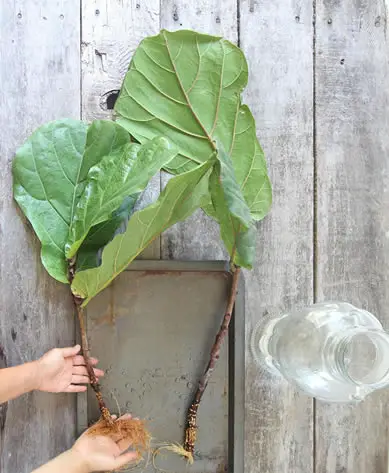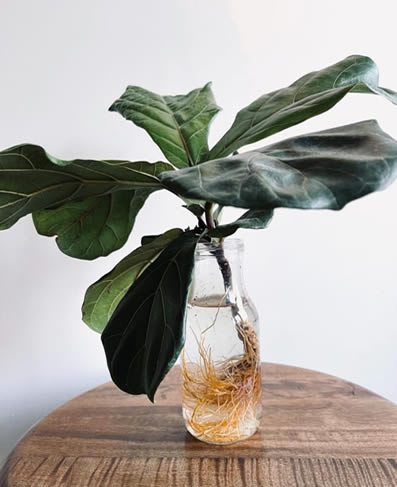Propagating a Fiddle Leaf Fig (Ficus lyrata) might sound intimidating, but it’s actually very doable with the right technique and a bit of patience. Whether your goal is to tame a tall, leggy plant or create fresh new growth to share or replant, propagation is a rewarding way to multiply the beauty of this bold indoor tree.
Here’s a complete guide to propagating your Fiddle Leaf Fig—from selecting a healthy stem to rooting it in water, soil, or even using air layering.
Table of Contents
- Where to Begin: Choosing the Right Time and Cuttings
- Water Propagation: Watching Roots Form Step-by-Step
- Soil Propagation: Rooting Directly in Potting Mix
- Air Layering: A Method for Propagating Larger or Leggy Plants
- Outdoor Propagation: Can You Root a Fiddle Leaf Fig Outside?
- Caring for Newly Rooted Cuttings: What Happens After Rooting
- Common Propagation Problems and How to Troubleshoot
- Final Thoughts
Where to Begin: Choosing the Right Time and Cuttings
The best time to propagate a Fiddle Leaf Fig is in spring or early summer, when the plant is actively growing.
Choose a healthy, non-woody stem with at least one leaf and one visible node.

A node is the bump on the stem where leaves emerge—it’s the key to successful rooting.
For top cuttings, snip just below a node using sharp, clean pruning shears.
Each cutting should ideally be 6–10 inches long with one or two leaves attached.
If the stem is too woody or overly thick, it may struggle to root.
Water Propagation: Watching Roots Form Step-by-Step
Place the cutting in a clear glass jar of room-temperature water, making sure the node is submerged but the leaf stays above the surface.
Keep the jar in bright, indirect light and change the water every few days to prevent bacteria buildup.
Roots usually begin to appear after 2 to 4 weeks, and you can transplant the cutting into soil once roots are 2–4 inches long.
Bonus Tip: Adding a few drops of floral feed or a diluted, balanced liquid fertilizer, like this one, to the water can provide nutrients that support the cutting during root development.

However, it’s important to use a very diluted solution to avoid over-fertilizing, which can harm the cutting.
This little care kit is ideal for Fiddle Leaf Fig as it contains everything you need to take care of your plant and it also comes with an ideal fertilizer.
Some growers have found that this can help maintain the health of the cutting during the rooting process.
Water propagation is easy and lets you watch the rooting process, but transferring to soil later requires a careful hand to avoid transplant shock.
Soil Propagation: Rooting Directly in Potting Mix
For soil propagation, dip the cut end of your stem in rooting hormone (optional but helpful), then plant it in a small pot filled with well-draining, slightly moist soil.
Cover the pot loosely with a clear plastic bag to trap humidity and create a mini greenhouse.
Place it in bright, indirect light and open the bag every few days to allow fresh air in.
You won’t see roots developing the way you would in water, but you can check for resistance after a few weeks by gently tugging the stem—if it gives resistance, roots are forming.
Air Layering: A Method for Propagating Larger or Leggy Plants
Air layering is great for propagating a tall, leggy Fiddle Leaf Fig without cutting it all at once.
Choose a healthy section of stem with a node and lightly slice into the bark with a clean knife.
Wrap damp sphagnum moss around the cut, then cover it with plastic wrap and secure both ends.
Keep the moss moist, and roots should develop within a month or two.
Once a good root system has formed, you can cut below the rooted section and pot it up.
This method is low-risk for the parent plant and often yields stronger results.
Outdoor Propagation: Can You Root a Fiddle Leaf Fig Outside?
In warm, humid climates (zones 10–12), you can propagate Fiddle Leaf Fig cuttings outdoors in spring or early summer.

Place the cutting in moist, shaded soil or keep it in a protected spot under a covered patio.
Make sure temperatures stay consistently above 65°F and avoid exposure to direct sun, wind, or heavy rain while rooting.
Outdoor humidity can help speed up the process, but pests and soil rot are risks, so monitor closely.
If you’re propagating in a pot outdoors, use a plastic dome or humidity tent to protect the cutting and keep the environment stable.
Caring for Newly Rooted Cuttings: What Happens After Rooting
Once your cutting has developed a healthy root system—whether in water, soil, or moss—it’s time to pot it up in a well-draining indoor plant mix.
Use a small pot at first to avoid waterlogging the roots. Water it lightly and place it in bright, indirect light.
New growth usually appears within a month or two.
Keep humidity high, watering moderate, and avoid fertilizing for the first few weeks while the plant adjusts. After that, you can transition into a regular care routine.
Be sure to read our article Fiddle Leaf Fig Care: How to Grow a Bold, Iconic Plant That Makes a Statement for more detailed care instructions.
Common Propagation Problems and How to Troubleshoot
Cuttings that rot in water are usually caused by stagnant water or low light
Fix it by changing the water every few days and keeping the cutting in a bright, warm space
Leaves that drop off soon after cutting may mean the cutting was taken from a stressed or unhealthy plant
Fix it by only propagating from strong, actively growing stems and trimming any lower leaves before rooting
Roots that grow slowly or not at all may be the result of low temperatures or poor lighting
Fix it by moving the cutting to a warmer, brighter spot and trying a humidity dome or heat mat if needed
Moldy or dry moss in air layering can prevent roots from forming
Fix it by misting the moss regularly and making sure the plastic wrap is sealed but breathable
Wilting after transplanting from water to soil is usually transplant shock
Fix it by potting gently, keeping the soil lightly moist, and avoiding full sun or heavy feeding for the first few weeks
Final Thoughts
Propagating a Fiddle Leaf Fig is a rewarding way to grow your plant family or share a piece of your favorite tree with someone else.
Whether you root in water, soil, or moss, the key is patience, the right conditions, and a little bit of care.
Give your cuttings bright light, steady warmth, and a gentle touch, and soon you’ll be watching brand-new figs grow from your own hands.

